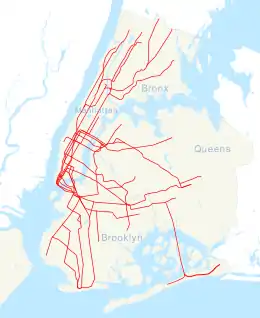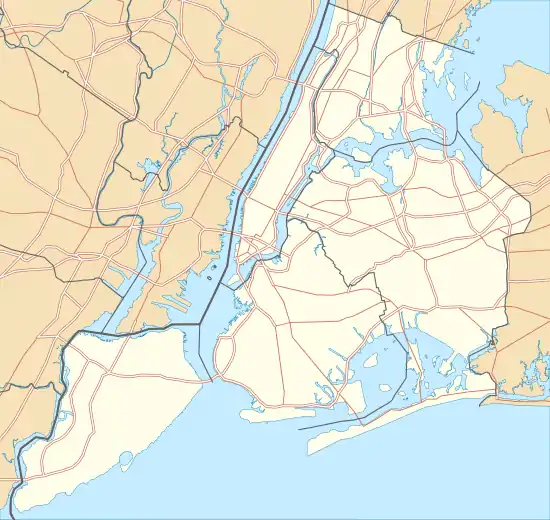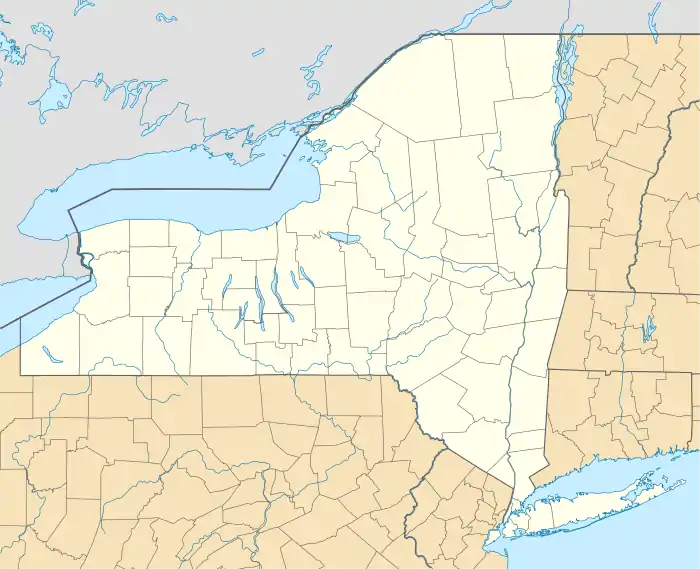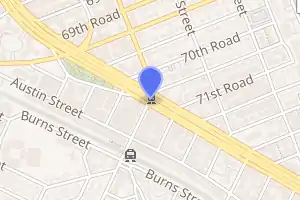Forest Hills–71st Avenue station
Forest Hills–71st Avenue (previously known as 71st–Continental Avenues) is an express station on the IND Queens Boulevard Line of the New York City Subway, located on Queens Boulevard at 71st (Continental) Avenue in Forest Hills, Queens. It is served by the E and F trains at all times, the <F> train during rush hours in the peak direction, the R train at all times except late nights, and the M train on weekdays except late nights. It serves as the terminus for the latter two services.
Forest Hills–71 Avenue | |||||||||||||||||||||||||||||||||||||||||||||||||||||||||||||||||||||||||||||||||||||||||||||||||||||||||||||||||||||||||||||||||||
|---|---|---|---|---|---|---|---|---|---|---|---|---|---|---|---|---|---|---|---|---|---|---|---|---|---|---|---|---|---|---|---|---|---|---|---|---|---|---|---|---|---|---|---|---|---|---|---|---|---|---|---|---|---|---|---|---|---|---|---|---|---|---|---|---|---|---|---|---|---|---|---|---|---|---|---|---|---|---|---|---|---|---|---|---|---|---|---|---|---|---|---|---|---|---|---|---|---|---|---|---|---|---|---|---|---|---|---|---|---|---|---|---|---|---|---|---|---|---|---|---|---|---|---|---|---|---|---|---|---|---|---|
 Manhattan bound platform | |||||||||||||||||||||||||||||||||||||||||||||||||||||||||||||||||||||||||||||||||||||||||||||||||||||||||||||||||||||||||||||||||||
| Station statistics | |||||||||||||||||||||||||||||||||||||||||||||||||||||||||||||||||||||||||||||||||||||||||||||||||||||||||||||||||||||||||||||||||||
| Address | 71st Avenue & Queens Boulevard Forest Hills, NY 11375 | ||||||||||||||||||||||||||||||||||||||||||||||||||||||||||||||||||||||||||||||||||||||||||||||||||||||||||||||||||||||||||||||||||
| Borough | Queens | ||||||||||||||||||||||||||||||||||||||||||||||||||||||||||||||||||||||||||||||||||||||||||||||||||||||||||||||||||||||||||||||||||
| Locale | Forest Hills | ||||||||||||||||||||||||||||||||||||||||||||||||||||||||||||||||||||||||||||||||||||||||||||||||||||||||||||||||||||||||||||||||||
| Coordinates | 40.721404°N 73.844004°W | ||||||||||||||||||||||||||||||||||||||||||||||||||||||||||||||||||||||||||||||||||||||||||||||||||||||||||||||||||||||||||||||||||
| Division | B (IND) | ||||||||||||||||||||||||||||||||||||||||||||||||||||||||||||||||||||||||||||||||||||||||||||||||||||||||||||||||||||||||||||||||||
| Line | IND Queens Boulevard Line | ||||||||||||||||||||||||||||||||||||||||||||||||||||||||||||||||||||||||||||||||||||||||||||||||||||||||||||||||||||||||||||||||||
| Services | E F M R | ||||||||||||||||||||||||||||||||||||||||||||||||||||||||||||||||||||||||||||||||||||||||||||||||||||||||||||||||||||||||||||||||||
| Transit | |||||||||||||||||||||||||||||||||||||||||||||||||||||||||||||||||||||||||||||||||||||||||||||||||||||||||||||||||||||||||||||||||||
| Structure | Underground | ||||||||||||||||||||||||||||||||||||||||||||||||||||||||||||||||||||||||||||||||||||||||||||||||||||||||||||||||||||||||||||||||||
| Platforms | 2 island platforms cross-platform interchange | ||||||||||||||||||||||||||||||||||||||||||||||||||||||||||||||||||||||||||||||||||||||||||||||||||||||||||||||||||||||||||||||||||
| Tracks | 4 | ||||||||||||||||||||||||||||||||||||||||||||||||||||||||||||||||||||||||||||||||||||||||||||||||||||||||||||||||||||||||||||||||||
| Other information | |||||||||||||||||||||||||||||||||||||||||||||||||||||||||||||||||||||||||||||||||||||||||||||||||||||||||||||||||||||||||||||||||||
| Opened | December 31, 1936 | ||||||||||||||||||||||||||||||||||||||||||||||||||||||||||||||||||||||||||||||||||||||||||||||||||||||||||||||||||||||||||||||||||
| Station code | 261[1] | ||||||||||||||||||||||||||||||||||||||||||||||||||||||||||||||||||||||||||||||||||||||||||||||||||||||||||||||||||||||||||||||||||
| Accessible | |||||||||||||||||||||||||||||||||||||||||||||||||||||||||||||||||||||||||||||||||||||||||||||||||||||||||||||||||||||||||||||||||||
| Opposite- direction transfer | Yes | ||||||||||||||||||||||||||||||||||||||||||||||||||||||||||||||||||||||||||||||||||||||||||||||||||||||||||||||||||||||||||||||||||
| Former/other names | 71st–Continental Avenues–Forest Hills | ||||||||||||||||||||||||||||||||||||||||||||||||||||||||||||||||||||||||||||||||||||||||||||||||||||||||||||||||||||||||||||||||||
| Traffic | |||||||||||||||||||||||||||||||||||||||||||||||||||||||||||||||||||||||||||||||||||||||||||||||||||||||||||||||||||||||||||||||||||
| 2019 | 8,027,234[2] | ||||||||||||||||||||||||||||||||||||||||||||||||||||||||||||||||||||||||||||||||||||||||||||||||||||||||||||||||||||||||||||||||||
| Rank | 42 out of 424[2] | ||||||||||||||||||||||||||||||||||||||||||||||||||||||||||||||||||||||||||||||||||||||||||||||||||||||||||||||||||||||||||||||||||
| Station succession | |||||||||||||||||||||||||||||||||||||||||||||||||||||||||||||||||||||||||||||||||||||||||||||||||||||||||||||||||||||||||||||||||||
| Next east | Kew Gardens–Union Turnpike (express): E 75th Avenue (local): E (Terminal): M World's Fair (IND World's Fair Line; demolished) | ||||||||||||||||||||||||||||||||||||||||||||||||||||||||||||||||||||||||||||||||||||||||||||||||||||||||||||||||||||||||||||||||||
| Next west | 67th Avenue (local): E Jackson Heights–Roosevelt Avenue (express): E | ||||||||||||||||||||||||||||||||||||||||||||||||||||||||||||||||||||||||||||||||||||||||||||||||||||||||||||||||||||||||||||||||||
| |||||||||||||||||||||||||||||||||||||||||||||||||||||||||||||||||||||||||||||||||||||||||||||||||||||||||||||||||||||||||||||||||||
| |||||||||||||||||||||||||||||||||||||||||||||||||||||||||||||||||||||||||||||||||||||||||||||||||||||||||||||||||||||||||||||||||||
| |||||||||||||||||||||||||||||||||||||||||||||||||||||||||||||||||||||||||||||||||||||||||||||||||||||||||||||||||||||||||||||||||||
| |||||||||||||||||||||||||||||||||||||||||||||||||||||||||||||||||||||||||||||||||||||||||||||||||||||||||||||||||||||||||||||||||||
History

The Queens Boulevard Line was one of the first lines built by the city-owned Independent Subway System (IND),[3][4][5] and stretches between the IND Eighth Avenue Line in Manhattan and 179th Street and Hillside Avenue in Jamaica, Queens.[3][5][6] The Queens Boulevard Line was in part financed by a Public Works Administration (PWA) loan and grant of $25 million.[7] One of the proposed stations would have been located at 71st Avenue. During the late 1920s, in anticipation of the arrival of the subway, land was bought by developers and was built up.[8] Zoning laws were changed to allow fifteen-story apartment buildings to be built,[9] and made the neighborhood of Forest Hills a more desirable place to live, especially as it was an express stop. Queens Borough President George Harvey predicted that the introduction of the subway to Forest Hills would turn Queens Boulevard into the "Park Avenue of Queens."[8]:73
On December 31, 1936, the IND Queens Boulevard Line was extended by eight stops, and 3.5 miles (5.6 km), from its previous terminus at Roosevelt Avenue to Union Turnpike, and the 71st Avenue station opened as part of this extension.[10][11]
The station was proposed as a transfer station between the never-built Queens Super-Express Bypass as part of the 1968 Program for Action, which would have significantly expanded railway and subway service in the five boroughs.[12] Under a 1984 plan, the new express station would have been one of three stops on the 63rd Street Line extension east of 21st Street–Queensbridge, the other two stops being at Northern Boulevard and Woodside.[12] The bypass station would have had a mezzanine, two platform levels (an upper platform for Jamaica- and Southeast Queens-bound trains; a lower platform for Manhattan-bound trains), a new elevator entrance, and an expanded mezzanine, with escalators and stairs connecting the new platform levels to the existing platforms.[12][13] The new station would have been built on the south side of Queens Boulevard, south of the existing station.[12][13]
In 2014, the Metropolitan Transportation Authority built a new signal tower for the Manhattan-bound platform. The agency also upgraded the station to compliance with the 1990 Americans With Disabilities Act; the upgrade included passenger elevators to serve the street level, mezzanine and platforms. This project was completed by March 2014 after a three-month delay.[14][15][16] However, a ribbon-cutting for the new elevators was not held until May 15, 2014.[17]
Station layout
| G | Street level | Exit/entrance |
| M | Mezzanine | Fare control, station agent |
| P Platform level |
Southbound local | ← ← ← |
| Island platform | ||
| Southbound express | ← ← | |
| Northbound express | | |
| Island platform | ||
| Northbound local | | |
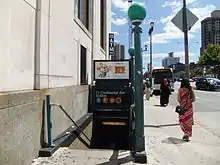
The station has four tracks and two island platforms. It is the northern terminal for the local M and R trains, which stop on the outer tracks. To the east, the line widens to six tracks, with two tracks starting between the local and express tracks in each direction, then ramping down to a lower level, where they widen to four tracks and run under the 75th Avenue station to Jamaica Yard. F trains stop on the express track at all times, but switch to the local track to the east and continue on to Jamaica–179th Street. E trains stop on the express tracks at all times except late nights, when they make local stops along the Queens Boulevard Line. To the east, they continue on the express tracks (except evenings and weekends when they switch to the local track like the F) to Jamaica Center–Parsons/Archer, with limited rush-hour express service to 179th Street. This station has four punch boxes two at the eastern end and western end.[18]
Both outer track walls have a lime green tile band with a black border and small "71st AVE" signs below them, in white lettering on black tiles.[19] The station's columns are painted in lime green with signs reading "71 - Forest Hills", while older signs on the black columns between the express tracks read "CONTINENTAL AVENUE - Forest Hills" in black lettering on a white border.[20][21]
A signal tower and dispatchers' office is at the extreme western end of the southbound platform.
Exits
There are two fare control areas on the full width mezzanine above the platforms and tracks. The western section of the mezzanine is bounded on the west by the exit to the western side of 70th Road and the northern side of Queens Boulevard. There used to be a part-time booth at this location. On the east end, the fare control area is sided by a passageway out of fare control connecting the exits between 70th Road and 71st Avenue. There used to be a part-time booth at the northern section of the passageway. An elevator is located at the southern exit between 70th Road and 71st Avenue and makes the station ADA-accessible. The second fare control area is in between the aforementioned fare free passageway and the passageways connecting to the exits at 71st Avenue. At the eastern end of the mezzanine there is a staircase leading to Queens Boulevard between 71st Avenue and 71st Road on the northern side, and a staircase leading to the intersection of 71st Avenue and Queens Boulevard on the south side. There are seven staircases to each platform.[22][23][24]
Signage
On the current MTA map[25] and published timetables,[26] the station name is "Forest Hills–71st Avenue." In the past, "Continental Avenue" (the alternative name of 71st Avenue used in nearby Forest Hills Gardens) has been included in the name[27] and is used on the rollsigns of older rolling stock such as the R32. As of 2011, the platform signage reads 71–Continental Av–Forest Hills.
Points of interest
Nearby points of interest include:
- Austin Street, a major business thoroughfare in Forest Hills, located south of the station.[23]
- Forest Hills LIRR Station, located in Station Square in Forest Hills Gardens at Burns Street.[22][23]
- Ridgewood Savings Bank, Forest Hills Branch, designated a landmark by the New York City Landmarks Preservation Commission since 2000.[28]
- West Side Tennis Club, containing Forest Hills Stadium, which hosted the US Open tennis tournament until 1977.[22][23]
References
- "Station Developers' Information". Metropolitan Transportation Authority. Retrieved June 13, 2017.
- "Facts and Figures: Annual Subway Ridership 2014–2019". Metropolitan Transportation Authority. 2020. Retrieved May 26, 2020.
- Duffus, R.L. (September 22, 1929). "OUR GREAT SUBWAY NETWORK SPREADS WIDER; New Plans of Board of Transportation Involve the Building of More Than One Hundred Miles of Additional Rapid Transit Routes for New York" (PDF). The New York Times. Retrieved August 19, 2015.
- "QUEENS SUBWAY WORK AHEAD OF SCHEDULE: Completion Will Lead to Big Apartrnent Building, Says William C. Speers" (PDF). The New York Times. April 7, 1929. Retrieved September 1, 2015.
- "Queens Lauded as Best Boro By Chamber Chief". Brooklyn Daily Eagle. September 23, 1929. p. 40. Retrieved October 4, 2015 – via Newspapers.com.
- New York Times, New Subway Routes in Hylan Program to Cost $186,046,000, March 21, 1925, page 1
- "TEST TRAINS RUNNING IN QUEENS SUBWAY; Switch and Signal Equipment of New Independent Line Is Being Checked" (PDF). The New York Times. December 20, 1936. ISSN 0362-4331. Retrieved April 26, 2016.
- Hirshon, Nicholas; Romano, Foreword by Ray (January 1, 2013). Forest Hills. Arcadia Publishing. ISBN 9780738597850.
- "QUEENS TO HAVE 15-STORY HOUSE; Tall Structure for New Residential Development in ForestHills Area.NEAR BOULEVARD SUBWAYSeveral Blocks Rezoned for High Buildings Between Jamaicaand Kew Gardens. Apartment Height's Increase" (PDF). The New York Times. March 23, 1930. ISSN 0362-4331. Retrieved April 26, 2016.
-
- "NEW RETAIL AREA IN QUEENS BOROUGH; Sees Roosevelt Avenue Subway Station as Great Shopping Centre. ADVANTAGES POINTED OUT Accessibility to Many Home Communities Assures Potential Market" (PDF). The New York Times. July 9, 1933. ISSN 0362-4331. Retrieved April 26, 2016.
- "Reproduction Poster of Extension to Union Turnpike – Kew Gardens". Flickr – Photo Sharing!. Retrieved April 26, 2016.
- "CITY SUBWAY OPENS QUEENS LINK TODAY; Extension Brings Kew Gardens Within 36 Minutes of 42d St. on Frequent Trains" (PDF). The New York Times. December 31, 1936. ISSN 0362-4331. Retrieved April 26, 2016.
- "OPENING MOVED UP FOR NEW SUBWAY; Traffic to Be Started on the Extension of City's Line to Kew Gardens on Thursday. EIGHT STATIONS ARE ADDED La Guardia and Official Party Will Inspect New Queens Branch on Wednesday" (PDF). The New York Times. December 26, 1936. ISSN 0362-4331. Retrieved April 26, 2016.
- "PWA Party Views New Subway Link: Queens Section to Be Opened Tomorrow Is Inspected by Tuttle and Others" (PDF). nytimes.com. The New York Times. December 30, 1936. Retrieved June 27, 2015.
- Queens Subway Options Study, New York: Environmental Impact Statement. United States Department of Transportation, Metropolitan Transportation Authority, Urban Mass Transit Administration. May 1984. pp. 83–. Retrieved July 10, 2016.
- Erlitz, Jeffrey (February 2005). "Tech Talk". New York Division Bulletin. Electric Railroaders Association. 48 (2): 9–11. Retrieved July 10, 2016.
- "Forest Hills Subway Station Project Delayed by Three Months". DNAinfo New York. Archived from the original on February 9, 2014.
- "Forest Hills Subway Station Renovation to End in March, MTA Says". DNAinfo New York. Archived from the original on March 27, 2014.
- "71st Avenue Station Renovation in Forest Hills will Wrap This Month". brownstoner.com.
- "Forest Hills-71st Av. ADA Elevators". Flickr.
- Lynch, Andrew (2020). "New York City Subway Track Map" (PDF). vanshnookenraggen.com. Retrieved February 6, 2020.
- Cox, Jeremiah (September 26, 2004). The lime green trim and 71st Ave text underneath it along the platform walls at 71-Continental Av (image).
- DanTD (March 16, 2017). Continental Avenue-Forest Hills; Old Sign (photograph). Retrieved July 29, 2017.
- Cox, Jeremiah (June 2, 2008). Looking down the Manhattan-bound platform at 71-Forest Hills as the column signs say (image).
- "SUBWAY-SIDEWALK INTERFACE PROJECT: 71ST/CONTINENTAL AVENUES STATION" (PDF). transalt.org. Transportation Alternatives, City of New York, New York City Department of City Planning, New York City Department of Transportation. Retrieved September 30, 2015.
- "MTA Neighborhood Maps: Forest Hills" (PDF). mta.info. Metropolitan Transportation Authority. 2015. Retrieved July 6, 2015.
- Cox, Jeremiah (June 5, 2008). "Looking down the mezzanine towards the 70 Road & North Side Queens Blvd exit at 71-Continental Ave". thesubwaynut.com. Retrieved December 18, 2017.
- "Subway Map" (PDF). Metropolitan Transportation Authority. October 21, 2019. Retrieved January 18, 2018.
- "E Subway Timetable, Effective November 8, 2020" (PDF). Metropolitan Transportation Authority. Retrieved December 9, 2020.
- "NYC Subway Historical Maps". Retrieved September 27, 2007.
- "RIDGEWOOD SAVINGS BANK, FOREST HILLS BRANCH" (PDF). New York City Landmarks Preservation Commission. Retrieved January 27, 2018.
External links
| Wikimedia Commons has media related to Forest Hills – 71st Avenue (IND Queens Boulevard Line). |
- nycsubway.org – IND Queens Boulevard Line: 71st/Continental Aves./Forest Hills
- The Subway Nut — 71st Street–Continental Av–Forest Hills Pictures
- 71st Avenue entrance from Google Maps Street View
- Entrance between 71st Avenue and 70th Road from Google Maps Street View
- 70th Road entrance from Google Maps Street View
- Platforms from Google Maps Street View
